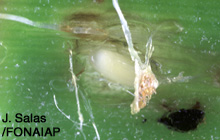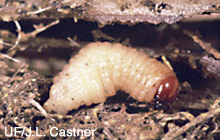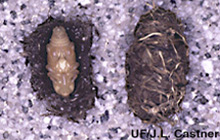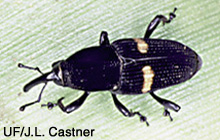

(L) egg (R) larva


(L) pupa (R) adult
Identification. Adults of this weevil range from 11-16 mm (0.4 to 0.6 of an inch) in length. They are black. Typically, each of the two elytra (wing covers) has a slightly curved, orange transverse line anterior to the middle of the length of the elytra. In some specimens the line appears red or yellow or is too faint to see easily. This is the only weevil of this description now occurring in Florida, but adults of some of the other Metamasius occurring in the Neotropical Region are very similar and need identification by an entomologist who is an expert in identification of weevils. There are few experts in weevil identification. Eggs, larvae, and pupae of Metamasius cannot now be identified to the species level.
Host plants. In Florida, the bromeliad thus far most attacked is Tillandsia utriculata, with lesser damage to T. fasciculata, T. paucifolia, T. balbisiana, and the hybrid T. x smalliana. In Mexico, the principal host plants seem to be several Tillandsia species. However, in nature in Mexico, this weevil is also known from Aechmea, Vriesia, and Catopsis. In Florida, it has attacked plants belonging to Aechmea, Ananas, Canistrum, Dyckia, Fernseea, Guzmania, Hohenbergia, Neoregelia, Nidularium, Orthophytum, Pitcairnia, Quesnelia, Tillandsia, and Vriesia. So far, there is no evidence of attack on plants other than bromeliads.
Feeding. Adult weevils nibble on leaves of many bromeliad species. However, the range of bromeliads in which female weevils lay their eggs is restricted at least to plants which have sufficient meristemmatic tissue to support development of larvae. Thus, Tillandsia ionantha, on which adults feed, is not a species on which females will lay eggs. It is feeding by larval weevils, which mine the meristemmatic tissue, that kills bromeliads. Larvae provided with an inadequate food supply produce small adults.
Development. Female weevils lay their minute, elongate, yellow eggs in slits that they cut in leaf bases. Development time of the eggs is unknown, but probably is not more than a few days. Larvae, hatching from the eggs, begin to mine, and take about two months to develop fully (to the pupal stage). During this time they undergo five molts. Fully-grown larvae shred bromeliad leaves to obtain fibres to make a cocoon, in which they pupate. Duration of the pupal stage is about two weeks. Adults emerge from the pupae. Adults need at least some few days to mature before they begin to reproduce. Adults seem to use flight for dispersal (to get from a bromeliad in one tree to a bromeliad in another), not to escape capture. The number of eggs that the average female is capable of laying is unknown.
Illustrations of M. callizona


(L) egg (R) larva


(L) pupa (R) adult
revised 2/02